Menu
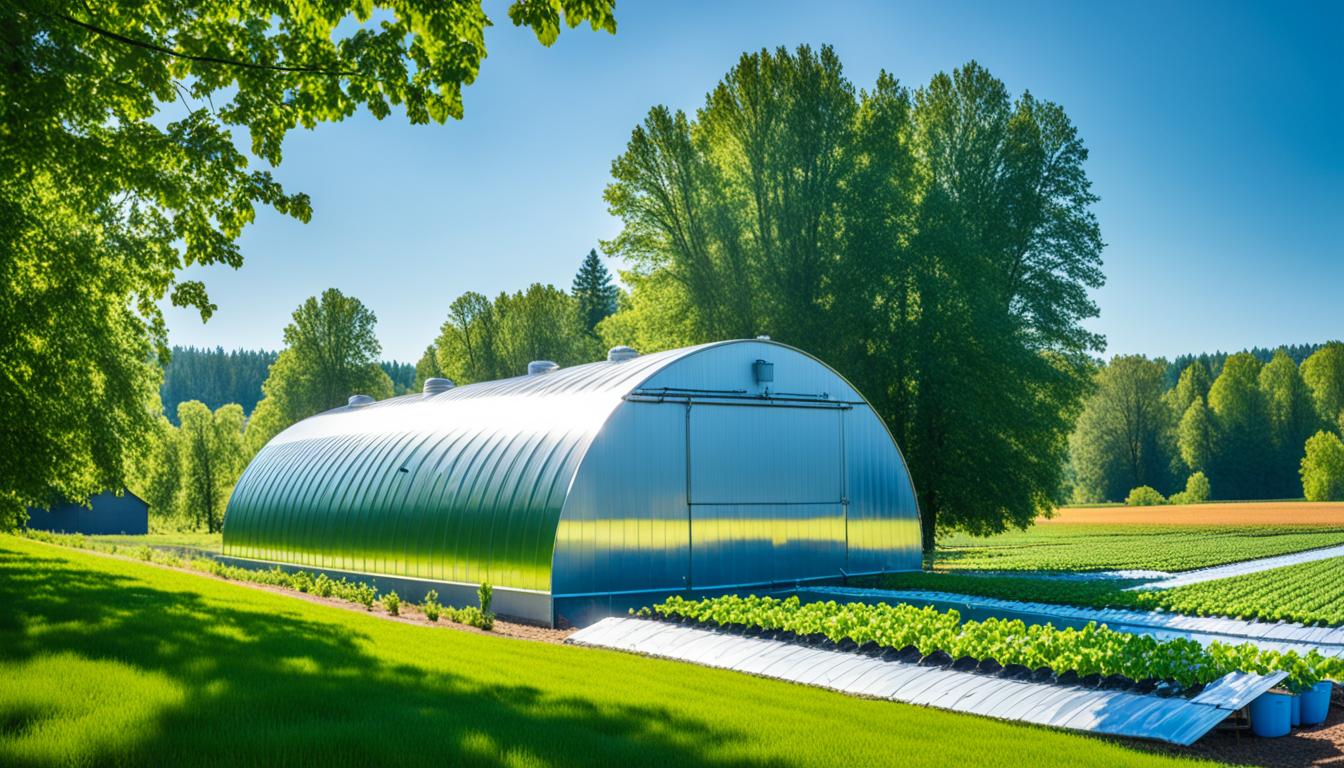
Rainwater harvesting can slash our need for treated water in gardens by up to 100% in cities. This shows farming’s potential for sustainable water use. It highlights a crucial practice for our planet’s health. As we dive into this topic, it’s clear how rainwater can be a big help for the earth. This is through smart collection and use.
Stephen Carr points out that rainwater harvesting does more than fix water challenges. It’s also a strong step towards conservation and innovation. This guide looks at how farming with rainwater can change how we use water in farming. It offers tips, strategies, and benefits of eco-friendly water practices.
Rainwater harvesting farming is a key part of sustainable agriculture. It helps use water effectively and keeps the environment in balance. By collecting rainwater, farmers can use less of the more traditional water sources. These are often not enough because of more people and climate changes. This helps ensure water is ready when needed, making farming better for the planet.
Rainwater collection systems are made to gather and store rain for different uses like watering fields and flushing toilets. They have parts like a collection area, a filter to catch debris, a big tank, and other tools to control the water. How you design these systems depends on what you need the water for, where you are, the size of the area that collects water, and much more.
It’s key to choose the right tank size based on how much rain falls in your area and how much water you need. These systems can last a long time, with guarantees for various parts lasting from a couple of years to several decades. It’s very important to keep them well-maintained by cleaning and checking different parts every year.
Good water management in farming means using water wisely. Rainwater harvesting helps in big ways. It saves fresh water by providing another source for things like government buildings and by making us less dependent on rivers and underground water sources. It also saves money, especially as the price of water goes up.
However, these systems do need power to run. This can increase carbon emissions and use energy. Sometimes, collecting lots of rainwater might even change the way water naturally moves in the ground and in rivers. This is why it’s crucial to plan carefully. During very dry periods, just relying on the collected rainwater might not be enough.
The practice of catching rain has a long history. Even in ancient times, people in places like the Negev Desert and parts of the United States found ways to do it. They showed that collecting rain helps grow more plants and better the land, especially in dry areas.
Rainwater harvesting is key to eco-friendly farming. It helps in water-efficient agriculture. It also makes farmers less reliant on others.
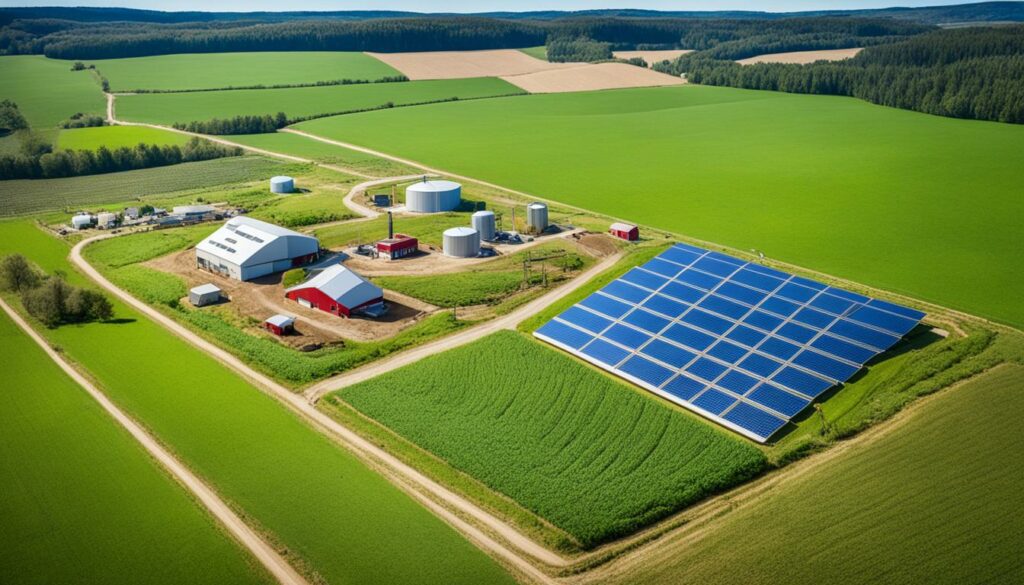
Rainwater harvesting focuses on saving and using water better. It uses techniques like collecting rain from roofs and slowing down its flow into the ground. This helps recharge underground water. It means less use of treated water, which is not as good for the environment. Sustainable farming methods, including no-till farming, also help keep the water from going to waste.
It’s important for farmers to use less city water. Harvesting rainwater helps them do this. It saves money and secures against shortage.
| Method | Benefits |
|---|---|
| Rain Gardens | Enhance groundwater recharge and reduce runoff. |
| Green Roofs | Improve water quality by filtering pollutants and reduce the need for water treatment. |
| Rain Barrels | Offer a simple way to save water for plants. |
These techniques help farmers stick to eco-friendly farming. They create a sustainable and water-wise farming model.
Rainwater harvesting starts with capturing rain from rooftops. This method offers a sustainable water source for farming. It also fits well with stormwater harvesting methods. Efficient gutters and downspouts channel water to storage. They ensure a steady water supply.
Installing gutters and downspouts is key in rainwater farming. They collect water from roofs. Then this water flows into storage. It’s important to have protection on gutters to stop debris. Downspouts help the water flow smoothly.
A good system might also have rain heads and first-flush diverters. Rain heads filter water at the start. First-flush diverters remove any dirt in the first rainwater.
After collecting rain, it needs good storage. Rain barrels, holding 50 to 100 gallons each, are a good start. For bigger needs, there are larger tanks. You can choose based on roof size, rainfall, and use.
For example, in Central Texas, a 1,000-square-foot roof can collect nearly 20,000 gallons a year. This water can be used for many things. Like watering plants, indoor uses that don’t need to be clean, or after filtering, it can be safe to drink.
| Roof Area (sq ft) | Annual Rainfall (inches) | Collected Rainwater (gallons) |
|---|---|---|
| 1,000 | 32 | 19,936 |
| 1,500 | 8-9 | 7,500-8,400 |
| 1,000 | 10 | 6,000 |
Such systems provide a sustainable water supply. They help with stormwater harvesting too. This reduces runoff, lowers soil erosion, and helps the environment.
Swales are important in *rainwater collection agriculture*. They help manage water in a sustainable way. By placing them carefully, farmers get more water, healthier soil, and plants. We will look at how to design and use swales, and their many benefits for the land.
To design a swale, it’s key to know how big it should be. Swales can be between 2-6 feet wide. They should be twice as deep as they are wide. For example, a 2-foot wide swale would be 1 foot deep. This approach fits many different landscapes, rainfall, and slopes.
For areas with a lot of rainwater or bigger swales, the main idea stays the same. Swales need to be level to spread the water evenly. They should follow the land’s natural curves. This stops the soil from moving and possible landslides.
In places where the ground is often wet, special ditches can help drain water. These ditches should slowly move the water away, keeping the soil strong and preventing erosion.
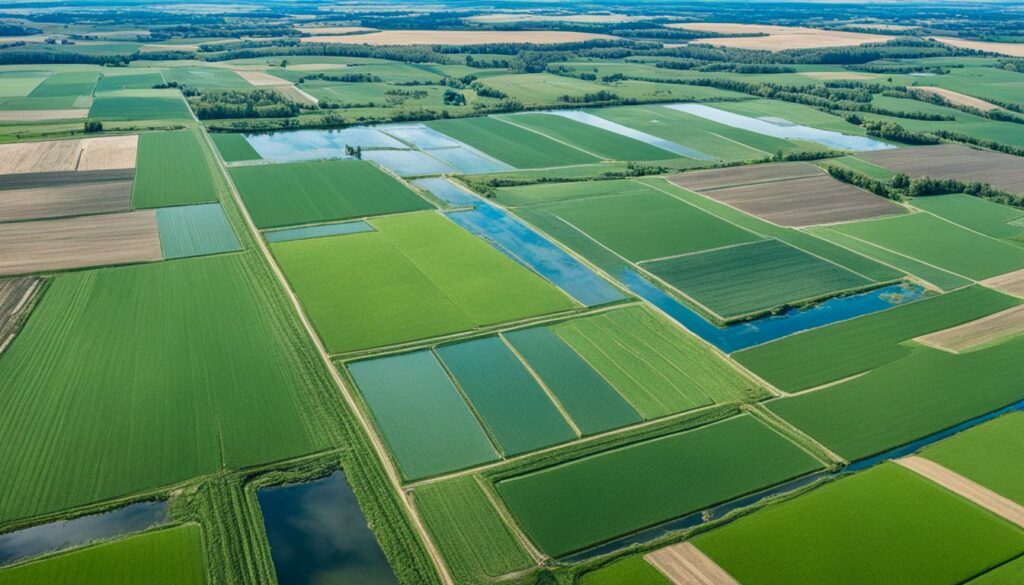
Well-designed swales are great for managing water in a green way. They can fill up underground water sources, help keep springs and creeks healthy, and stop floods and dry spells.
In growing trees, swales bring water right to the roots, helping trees grow faster. They create homes for different life forms, which make the soil richer and use less water.
Adding plants that cover the ground, like clover and thyme, keeps soil safe and holds onto water. Plants that put nitrogen back in the soil, like beans, lower the need for chemicals.
Using swales for fruit trees, like apples and pears, makes water use more efficient. Plants like lavender and rosemary draw in helpful insects. This makes a healthy home for all from the smallest bugs to the biggest plants.
Swales are a top choice for keeping soil moist, fertile, and great for growing different crops. They fit perfectly with the idea of handling water in nature-friendly ways.
In the 1950s, P.A. Yeomans introduced Keyline design to tackle water and soil problems. This farming method uses the natural shape of the land to manage water well. It moves water to the right places, making the soil more fertile and increasing farm output.
The main idea of Keyline is to keep water that would otherwise be lost. Every 1% more organic matter in the soil can mean 16,000 extra gallons of water. It not only helps with water issues but also makes the soil better and captures carbon.
This method helps with erosion and keeps salt in check. It lessens the risk of floods, evens out extreme water flows, and helps underground water in valleys. With the right setup, farmers can store 25% more water. This can make rainwater collecting up to four times more efficient.
To use Keyline design, farmers work with tools like the Yeomans plow. It’s great for hard ground. This tool helps water soak in, improves soil, and prevents erosion.
Farmers using Keyline see water run off less by 50%. Their lands become more varied with plants and small animals, 20% more than usual. Studies show these farms get 15% more crops than others not using Keyline design.
Keyline design offers a lot for water and land health. It helps meet goals for better water use, making farms stronger and more sustainable.
In places where water is hard to find, the Vallerani System is a clever answer. This method catches the little rain that falls to bring life back to dry areas. It’s a key way to manage water in tough environments.
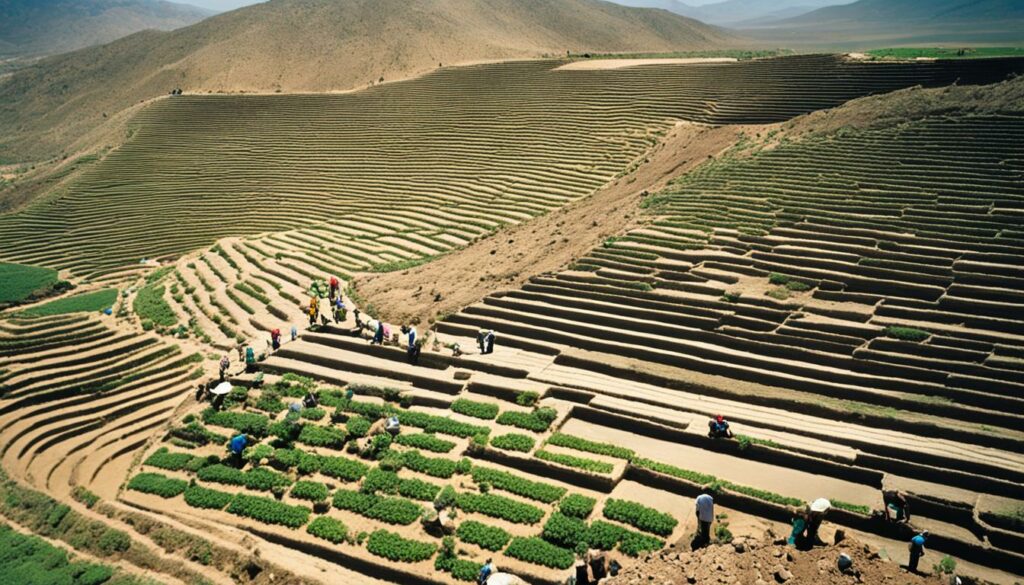
This method has spread to many places, like Burkina Faso, Senegal, and Jordan’s Badia Region. It adds 12 inches of rainwater each year. This boosts how much water is available, helping lands recover.
Studied in places like the Badia Rangelands and Kenya, it’s been found to work well. The system is also praised for fixing badly damaged ecosystems.
Between 2005 and 2007, it showed great results in China and Italy. These successes were shared in reports and news, promoting its use. Also, big groups like FAO and GIZ have included it in guides on water and soil conservation.
Known for being not too expensive to set up, the costs are between $32 and $116 per hectare in Jordan. The smart use of technology and location, like being 3000 feet up in Jordan, make it even better at collecting and spreading water.
| Publication | Region | Key Insight |
|---|---|---|
| ICARDA Paper | Badia Rangelands | Performance and Adaptation |
| KEFRI Final Paper | Kenya | Water Harvesting for Rehabilitation |
| FAO Global Guidelines | Drylands | Restoration Recommendations |
| GIZ Document | Various | Best Practices Highlighted |
| Sino-Italian Cooperation Report | Jordan | Implementation Insights |
Imprinting is a new way to improve how land holds water and helps plants grow, especially in tough places. It uses small areas that collect and keep rain. This way, dry soil can turn into rich ground with the right tools and techniques.
Studies show imprinting works better than older ways. In the Desert Southwest of the United States, it succeeded in growing plants nine times out of ten. Traditional methods only worked about one out of ten times. This proves how well imprinting works for farming with rainwater.
Imprinting changes the surface of the soil to make it better at soaking up water. It makes the soil more bumpy and holey. This improves how water goes into the ground. Such changes help a lot in farming that uses water wisely, where every raindrop matters a lot.
There are many types of imprinting tools, from big steel rollers to more handy ones since 1985. They have sharp edges that make certain patterns on the soil. These patterns help trap rainwater and are great for planting seeds.
Imprinting has not only helped single farms but whole areas like southern Arizona. It has turned thousands of hectares green in the last ten years. This shows how imprinting can help farming on a big scale, and improve the environment.
Imprinting also saves water by stopping it from evaporating quickly. It encourages plants to grow, even in dry areas. This makes the land healthier. So, using imprinting can make farming better for crops and the planet.
Trincheras and gabions are key in rainwater harvesting and eco-friendly farming. They stop erosion and help water soak into fields better. By building them smartly and putting them in the right places, they catch rainwater. This helps the soil and plants a lot.

For the last 30 years, Cuenca Los Ojos (CLO) has set a great example. They’ve built over 40,000 trincheras on 750 square kilometres of land. Trincheras are stone terraces. They slow down water and let it sink into the ground. This reduces erosion and makes a good place for rainwater farming.
Gabions, which are solid rocks in wire baskets, help with trincheras to manage water and stop erosion. CLO has built over 50 big gabion dams, some more than 20 metres tall. They are very useful in dry places with heavy rain. They catch much of the year’s rain in one big storm. This helps the land stay stable and lets plants and animals thrive again.
Combining trincheras and gabions uses both old and new ways to fight erosion. This gives hope for restoring dry areas all over the world. The success of CLO’s work shows how mixing old knowledge with new ideas really works.
The role of soil in *rainwater harvesting farming* and keeping water for agriculture is key. It’s like a natural sponge, soaking up and holding water. The soil’s organic matter is what makes it so good at this. Let’s look more into why soil organic matter matters and ways to make soil even better at keeping water.
Soil turns into a great water-saving system thanks to organic matter. A bit of good soil holds many helpful, tiny life forms. These include bacteria, fungi, protozoa, and nematodes. They all help the soil keep more water. Compost is a top choice for adding more of these helpful friends, making the soil even better at saving water.
There are other good things too, like mulch and compost tea. These make the soil’s structure open and ready to hold water. Don’t forget about worm castings. They work well with or instead of compost, helping the soil soak up and keep water more efficiently.
We can make soil better at holding water with various methods. Adding compost, mulch, and compost tea at the right times is a key practice. This stuff makes the soil’s structure better, especially its ability to hold water.
Mulches (from things like straw, wood chips, or leaves) on the soil’s surface stop water from disappearing, lessen erosion, and keep the ground at a good temperature. This all helps the soil hold water better. Worm castings, just a little bit, also do a lot for the soil’s structure, just like compost does.
Plants have been teaming up with small life forms for millions of years. This teamwork creates the right environment for these tiny life forms, which then benefit the plants. We can do something similar by adding organic matter to help the soil keep more water.
For a complete guide on improving soil, the Green Gardens Group is a great choice. They offer excellent advice for making soil better at *rainwater harvesting farming*.
To sum up, soil plays a huge role in *rainwater harvesting farming* by acting as a sponge. By adding organic matter and using methods to improve the soil’s structure, we can ensure our farming is sustainable. This way, we use less water and have more resilient farms.
Rooftop gardens mix rainwater harvesting with farming in cities. They bring green spaces to urban areas, helping balance the environment. They use rainwater to grow food and make the city look better.
Start by checking if your roof can hold the garden’s weight. Then, pick plants that do well on roofs and need little care. Herbs, leafy veg, and small fruits are good choices.
Keep plants from drowning by setting up a good drainage system. Use light soil and raised beds to help water flow better. Adding organic compost makes plants grow stronger.
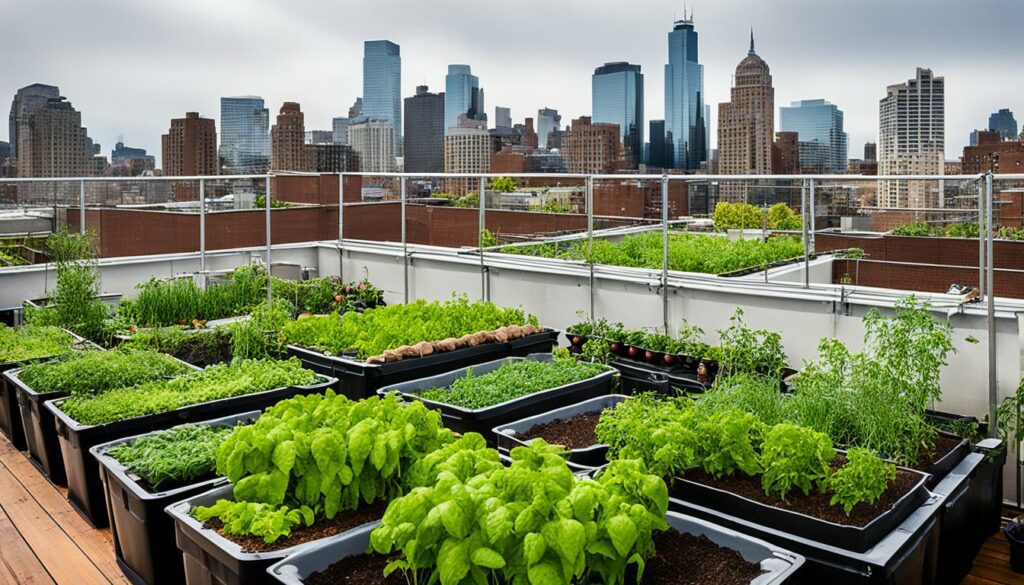
For cities short on water, rooftop gardens are key. You can set up your own rainwater system with gutters and filters. This water is great for plants because it’s pure.
Use drip hoses to water plants at their roots. This saves water and helps plants grow better. Set up timers to water your garden without much work. You can also use greywater if it hasn’t rained for a long time.
Cities like Mexico City are making a lot of their food on rooftops. This helps feed people and makes cities more green. It adds to city life by bringing in more plants and animals.
Rainwater irrigation systems are key for using water well in farming. They use rainwater to cut down on the need for other water sources. This boosts how much water is saved and used effectively by farmers.
There is a wide range of systems to suit different farm and weather conditions. Here are the main types:
Drip systems are an efficient way to water plants accurately. Here’s how to set one up:
Keep parts of the system clean and replace what’s worn out. Make sure the whole setup follows local rules on water collection. This way, everything will work its best, and you can make the most of your water.
| Component | Lifespan | Range |
|---|---|---|
| Storage Tanks | 15-30 years | FDA-approved, food-grade polyester resin |
| Pumps | 2-10 years | Warranty varies |
| Flow Meter | Monthly Calibration | Accurate water production measurement |
With rainwater systems and stormwater harvesting techniques, farmers can increase their crops. They will also save a lot of water, making a sustainable and smart water use system.
Many think rainwater harvesting is illegal or not effective. But, knowing the truth can change this. It lets us see the benefits and encourages more people to do it.
Some believe rainwater harvesting is against the law. But rules differ, and lots of places are actually supporting it. For example, 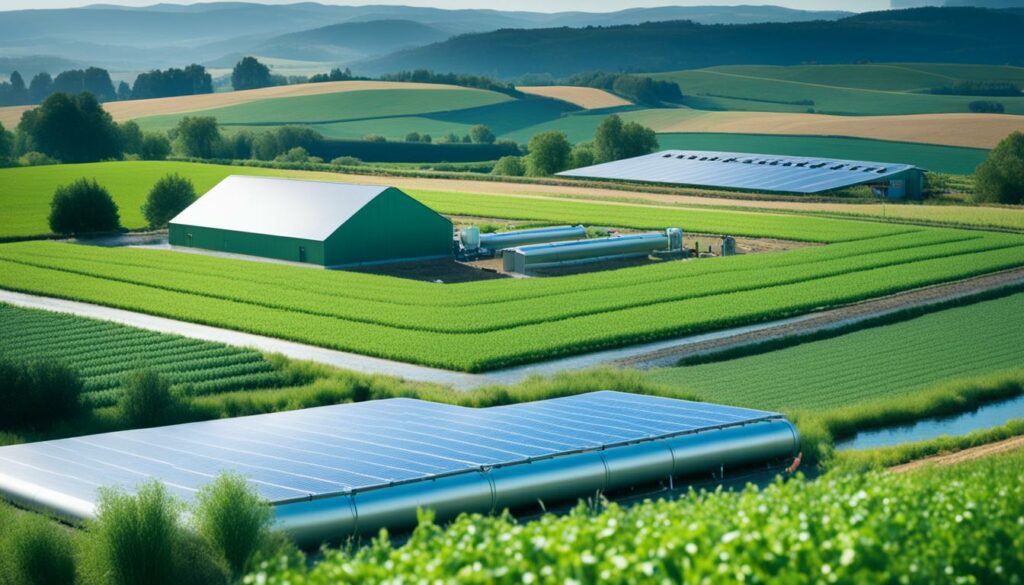
People tend to think rainwater harvesting doesn’t work well in drier places. But, smart methods can save a lot of water. Techniques like aquaponics and capturing every drop can make a big difference. In San Diego, rainwater helps a lot in farming. Methods like swales and keyline design make the most of rainwater, even in dry areas. So, rainwater harvesting can work wonders, even where it doesn’t rain much.
To sum up, there are laws and smart ways that make rainwater harvesting a good idea. It’s time to leave old ideas behind and use these methods more. This will help save water and manage it better all over.
When I work on passive rainwater harvesting, I examine the landscape’s potential for storing water. I use simple, cheap methods to capture rainwater. These techniques help farming in an eco-friendly and sustainable way.
Ditches and ponds are fundamental in these systems. They gather rainwater and store it for later use. Natural catchments hold water from surfaces like roads and roofs.
Porous pavement reduces runoff and helps water sink into the ground. French drains use gravel to direct excess water away from flood-prone areas. This helps manage water for irrigation.
Contour channels manage the natural flow of rainwater. They follow the land’s shape to spread water evenly. This reduces soil erosion and supports plant growth.
| Component | Function | Benefit |
|---|---|---|
| Catchment Areas | Collect rainwater from surfaces | Minimises runoff, maximises water collection |
| Distribution Systems | Channel water to holding areas | Efficient management of water flow |
| Landscape Holding Areas | Store accumulated rainwater | Ensures water availability for plant use |
Berms and swales help create rainwater-dependent landscapes. Adding the right plants is crucial too. Mulch stops water evaporation and keeps the soil moist.
Passive rainwater harvesting is great for the environment and farming. It reduces flooding and soil erosion. Plus, it promotes sustainable agriculture.
Keeping your rainwater system in good shape is vital. It ensures it works well for a long time. This includes cleaning the system and making sure mosquitoes and algae don’t make a home there.
Rain barrels are where the water first goes. It’s important to keep them clean for fresh, safe water. Checking them often helps you spot and fix any problems quickly.
Mosquitoes and algae can spoil your rainwater. It’s key to stop them.
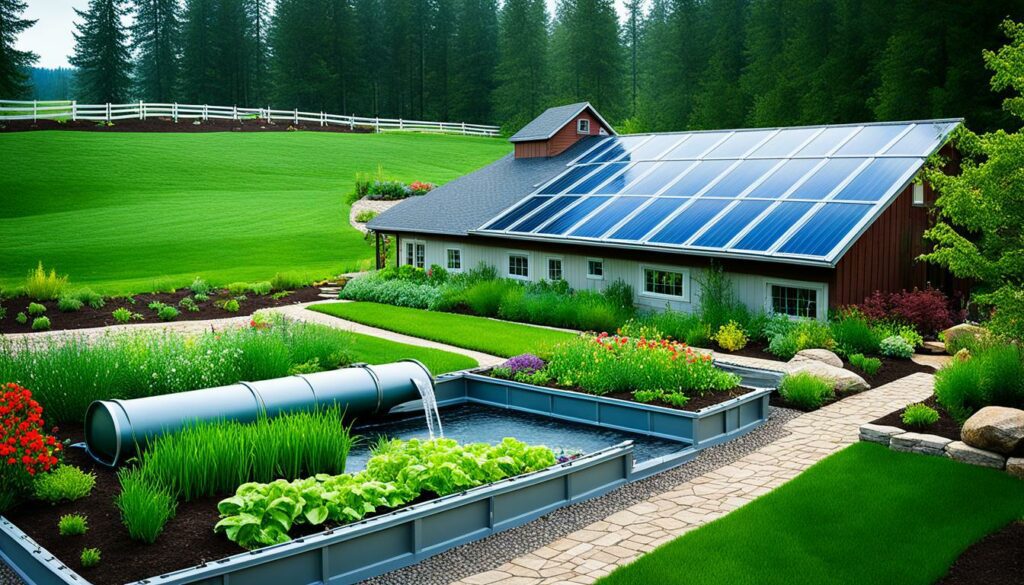
Taking care of your rainwater system helps with *rainwater harvesting farming*. It’s also good for *stormwater harvesting techniques*. This way, you have a dependable source of clean water. It supports farming and helps take care of the environment.
In wrapping up, rainwater harvesting farming shows great promise for our water needs today. It saves money by making use of rain for farming. This way, we rely less on wells. It offers clean water for many uses on the farm.
This method also helps refill groundwater, making it more productive. It lowers the need for drinking water, especially in dry areas. The practice of collecting rainwater is not new. Places like India have been doing it for ages, showing us its value over time.
In India, places like Arunachal Pradesh have seen great benefits from rainwater projects. This includes schools and hospitals. It proves that saving rainwater is good for the community and the environment.
In the same area, the Apatani tribe mixes growing rice with raising fish. This ancient method works well with saving water. It boosts farming and keeps the natural balance. As we face a world water crisis, turning to rainwater collection can make a big difference for us and our planet. For more ways on how to save water, check out this guide.
Rainwater farming is a key to a better, more sustainable future. Let’s learn from these simple, yet effective, methods. Act today to secure tomorrow’s water needs, ensuring a brighter tomorrow for everyone.
For farming, it’s key to have gutters and downspouts on rooftops. Rain barrels and tanks for storage are also crucial. Knowing how to use swales, ditches, and other natural methods is part of it too.
Rainwater harvesting is good for the farm and the environment. It lessens the need for city water. By using methods like swales and the Keyline design, it’s easier to keep soil moist and plants healthy.
Swales help a lot in farming by directing rainwater. They keep soil moist and stop it from washing away. This is great for the farm and for the planet.
The Keyline design lets the land guide water in the best way. This helps water to spread well, making the whole farm fruitful. It’s about using water smartly for good crops.
The Vallerani System is great for dry areas. It catches just a little rain to help plants grow and keep the soil moist. It turns dry land green again.
Imprinting creates special spots in the soil to hold water. This is good for plants and the earth. It makes the most of every drop of rain.
Trincheras and gabions are types of structures for stopping erosion and saving rainwater. Trincheras are like trenches that hold rain. Gabions are wire cages of rocks that help the water sink in. These techniques protect the soil and save water.
To make the soil better at keeping water, add compost and cover crops. Also, put on some organic mulches. This makes the soil like a sponge and helps plants grow strong.
Rooftop gardens can use rainwater to grow plants in the city. They need a good drainage system and special plants. Rainwater is stored to keep the garden green.
There are drip, sprinkler, and gravity-fed systems for watering plants with rainwater. They put water right where it’s needed, cutting waste. These are smart ways to use water on the farm.
The law on rainwater harvesting changes from place to place. For example, San Diego encourages it for saving water. Make sure to know the rules where you live to get any rewards for saving water.
Rainwater harvesting works really well in places that don’t get much rain. Methods like the Vallerani System make sure not a drop is wasted. They help farms survive when it’s dry.
Passive techniques use the land’s shape to catch water. Methods like ditches and ponds store rain for the soil. This keeps plants healthy without using too much water.
Keeping rain barrels clean and gutters free of stuff is very important. It stops mosquitoes and algae, ensuring the water is always good. This care means the water is ready to use on the farm.